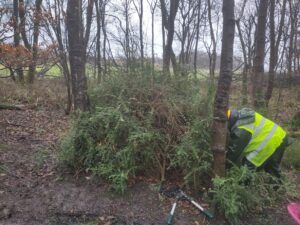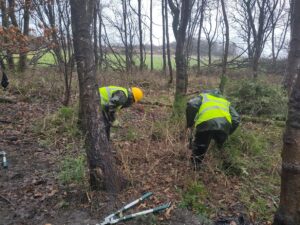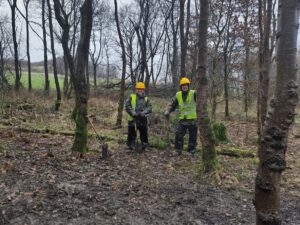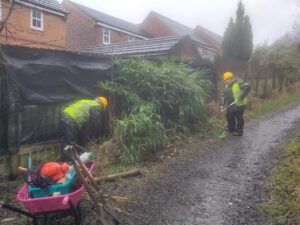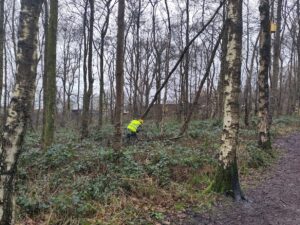On Tuesday 23rd January The Hyndburn’s Woodland’s Volunteers were back at Whinney Hill woodland for an invasive non-native species removal session. Invasive non-native species (INNS) are species (in this instance, plants) which have an original geographic range outside of the UK, have become established in the UK via ‘escaping’ from gardens or deliberate introduction, and are tolerant enough of our weather to veraciously spread once they are in the wild.
INNS can have a detrimental effect on our ecosystems as many do not have any predators or organisms which feed on them, thus they can grow unimpeded by browsing animals which prefer our native species. Through this, they can spread until they occupy a disproportionate amount of our environments and outcompete our native species for resources like light, soil space, and water.
On this session, we tackled a familiar INNS, Small-Leaved Cotoneaster. A common garden escapee which tends to form dense shrubs if left unchecked. The berries of Cotoneaster, while deadly-poisonous to Humans, are quite attractive to Blackbirds which facilitates their spread. The removal of this species involves using hand tools (such as loppers or bowsaws) to first cut back the shrub, followed by using spades to dig the entire root ball out to prevent re-growth.
A less familiar species was then tackled, a species of bamboo which had escaped from a garden! For now, this simply involved using loppers to cut the lengths of bamboo back to its base. This will be monitored in subsequent seasons to see how it copes.
The woodland’s volunteers also tackled 2 hazardous alder trees which were heavily leaning towards the path. For this, the volunteers used bow saws to first create a ‘gob cut’ (a horizontal v shaped cut) followed by a back cut to meet the gob (while maintaining a hinge between them) which allows the tree to fall into the v shaped cut.
Thank you to all our much appreciated volunteers who helped us through these difficult jobs, the woodland is a more natural place due to your efforts!
